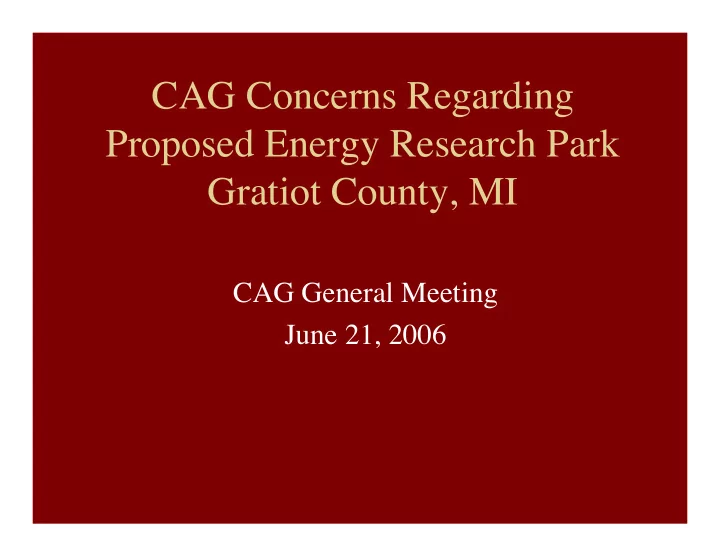

CAG Concerns Regarding Proposed Energy Research Park Gratiot County, MI CAG General Meeting June 21, 2006
What Do We Know At Present? • 2 Sets of investors looking at alternative energy park in/around Alma region • 1 investment would be Ethanol Plant – Local (state-wide) investors – Utilizing corn locally grown and processed – $ in the millions/tens of millions • 1 Investment would be clean coal plant with alternative energy research – Out-of-state investors – $ in the billions
CAG’s Concerns • Support local economy and monitor the environment at the same time • Learn from our past • Maintain a strong, working relationship with both industry and regulators along with maintaining strong ties with all of our representatives - federal/state/local • Maintain a focus on wellness and sustainability whenever we approach a situation
Brief Discussion of the Pros and Cons of Ethanol and Clean Coal Facilities
Ethanol - Basic Facts • Ethanol (ethyl alcohol) is a combustible liquid made from the fermentation and distillation of plant material - starches/sugars • Ethanol is added to gasoline to increase oxidation (raise octane rating) for slower, cleaner burn • Ethanol can be made from a variety of plant materials (mostly corn) and therefore is a renewable fuel • Cars CANNOT run on pure ethanol at present
Ethanol - Basic Facts • 30% of gas supply has ethanol blend • 13% of corn grown in U.S. went to ethanol manufacturing in 2005 • Other ethanol stock: sorghum, some grasses, grain and ‘biofuels’ such as corn stalks, vegetable matter • Wet and dry mill processes available: – Wet mill - produces products in addition to ethanol such as corn gluten, corn meal, corn oil, corn syrup – Dry mill - produces mostly ethanol and feed for cattle
Ethanol - Dry Mill Plants
Ethanol - Pros • Renewable fuel • Extends gasoline supplies • Makes gasoline burn ‘much’ cleaner • Highly biodegradable - all aspects of process • Can be utilized right now in cars and trucks • Is good for Michigan and particularly Gratiot County as this county produces more corn/acre than anywhere else in state • With more research, may be solution to bio-matter waste disposal
Ethanol - Cons • Objectionable odor during processing • Uses large volumes of water • Some air contaminants are produced including: – VOCs – Nitrous oxides – Methane – CO • Will require air and water permits from MDEQ
Ethanol - Economically Viable? • David Pimentel from Cornell University says: – Energy in ≠ energy out – For ethanol to become a ‘substitute’ for gas, 97% of all farmland would need to grow corn • So…how can ethanol be profitable? – Large government subsidies for farmers – Large government subsidies for alternative energy implementation
Clean Coal Technology Integrated Gasification and Carbon Cycling IGCC
IGCC vs. Traditional Coal • How is “coal” technology ‘alternative?’ – Coal is not burned as in traditional coal plants – Hydrogen is produced and captured – Main problem contaminants in traditional coal plants are captured (some sold as by-products) before entering the environment - including sulfur dioxide, nitrous oxides, mercury • Traditional coal is pulverized and burned to create steam --> turn a turbine --> generate electricity
IGCC Removal of Sulfur and Mercury / nitrous oxides Pressure + Steam Expanding syngas burned + Heat breaks down Turns turbine and heats Coal to CO, Syngas, H Water producing steam
IGCC - Pros • Uses a fossil fuel that is “plentiful” in the U.S. • Produces significantly less particulate and other air pollutants than traditional coal burning plants • Is much more efficient than traditional coal burning plants (42% and maybe as high as 60% in future) • Uses about 40% less water than a traditional coal burning plant • Produces 20% less carbon dioxide • More expensive per Kwh than traditional coal burning but cheaper than natural gas plants • Carbon dioxide sequestration is possible and CO 2 waste can be utilized in oil recovery
IGCC - Cons • Still produce enough air pollutants to warrant permits including: nitrous oxides, particulates and CO • Noisy • A little higher cost per Kwh than traditional coal burning plants but can be competitive if working with other energy sources • Slag produced is inert but needs to be disposed of or reused • Trucking coal slurry in and waste sulfur and mercury out presents risk
Proposed CAG Agenda Work With Our Strengths • Stay in touch with investors, city officials, county officials and state and federal representatives on this issue • Establish working relationship based on the model CAG has developed with regulatory agencies, industry and government • Maintain relationship with academic community (Alma College) to emphasize alternative energy research and reduce environmental impact • Learn from our past and promote environmental stewardship, planning and sustainability
Recommend
More recommend